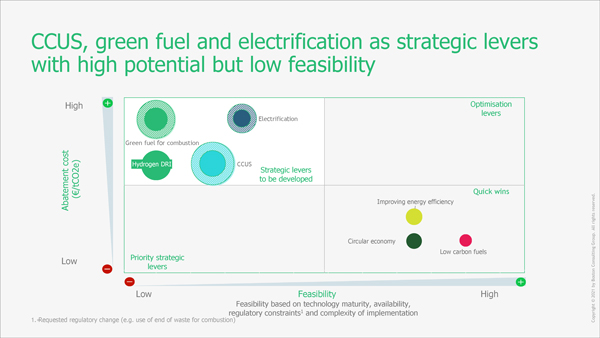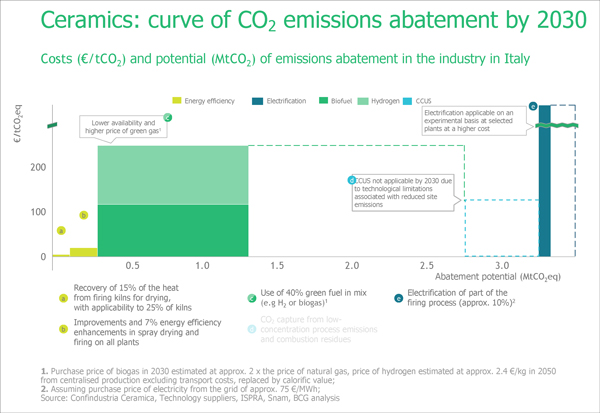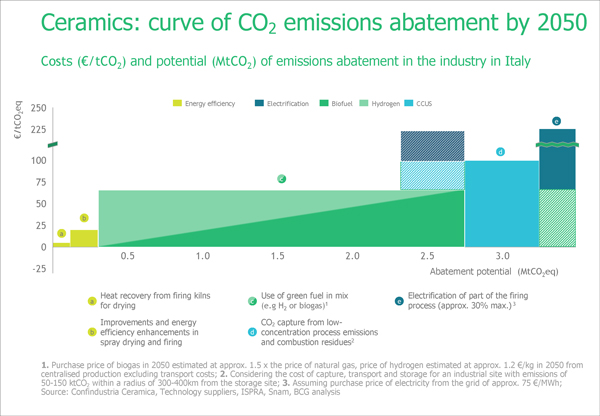Italy’s energy-intensive industries have presented a study by the Boston Consulting Group exploring the impacts, risks, potential and future development paths of decarbonisation to the Minister for Economic Development Giancarlo Giorgetti, the Minister for Ecological Transition Roberto Cingolani and the Minister for Agriculture Stefano Patuanelli.The aim of the study is to establish the real potential for decarbonisation of the so-called “hard-to-abate” industrial sectors by 2030 and 2050.
The sectors covered by the study (ceramics, chemicals, cement, paper, foundries, glass and steel) generate 20% of total Italian emissions, with the ceramic industry accounting for around 1%.
The competitiveness of these sectors, which generate €26 billion of gross value added and earn about 60% of their revenues from exports, is already at risk due to the Emissions Trading Scheme. The study shows that if these sectors were to purchase CO2 quotas on the market, they could face an unsustainable operating cost of €15 billion over a period of 10 years, equivalent to a total of between 8% and 20% of EBITDA.
Decarbonising these sectors can only be achieved through a diversified portfolio of solutions, some of which are not currently available. Energy efficiency, circular economy, low-carbon fuels, CO2 capture, green fuels (hydrogen and biomethane) and electrification could cut expected direct emissions by up to 40% by 2030.
The study also reveals that in order to achieve the 2050 targets, it will be necessary to fully exploit the potential of the three most innovative levers, namely CO2 capture, electrification and green fuels (hydrogen and biomethane). However, these solutions are not currently available and in any case have varying degrees of applicability to different sectors.
In the ceramic sector, the strategy of CCUS (Carbon Capture Usage and Storage) will have limited scope for application due to the low CO2 concentrations at the emission points, while electrification is of limited feasibility. The main strategy for achieving the 2050 decarbonisation targets is therefore to focus on green fuels, i.e. replacing natural gas with biogas/biomethane or hydrogen (up to 50% to avoid affecting the quality of the finished product).
This could be done by setting up a specific funding plan to promote research and development in these sectors and to support the implementation of new technologies and new energy carriers, together with additional mechanisms to bolster the measures already in place (e.g. white certificates and cogeneration) and tools for gaining access to competitive green energy.
Confindustria Ceramica, whose participation in the study does not imply its acceptance of the regulatory trends under way at an EU level (particularly as regards the ETS) nor the related costs, will continue to take all action necessary at both national and European levels to bring about the necessary amendments to enable the Italian ceramic industry to sustain an energy transition that is compatible with its exposure to international competition.
Download the summary of the study entitled “Decarbonisation of hard-to-abate sectors” (Italian version) conducted by the Boston Consulting Group on behalf of Interconnector Energy Italia s.c.p.a., Federbeton, Federacciai, Assocarta, Confindustria Ceramica, Federchimica, Assofond and Assovetro.
December 2021



 Architects
Architects
 Construction firms
Construction firms




